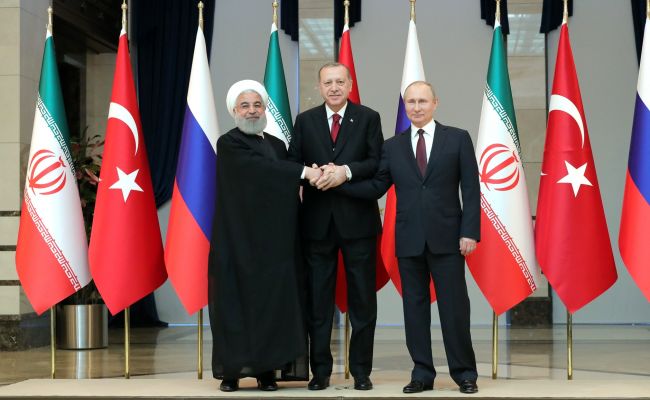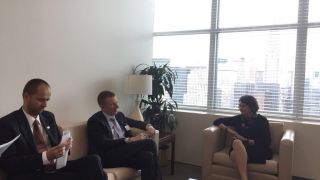Vladimir Putin’s visit to Turkey and his plans to attend a meeting of the Russian-Turkish cooperation council and a Russian-Turkish-Iranian summit on Syria were given wide coverage in the press as Putin’s first foreign visit after his reelection as President. On the first day, Apr 3, Putin met with his Turkish counterpart Recep Tayyip Erdogan with a view to discuss economic contacts. On Apr 4, Iranian President Hassan Rouhani joined his Russian and Turkish colleagues for talks on Syria.
The first day was a test for the sides’ attempts to normalize their ties after the Su-24 incident in Nov 2015. Since then, Russia and Turkey have significantly improved their economic contacts despite certain political contradictions. The meeting with Erdogan was fruitful, at least, Erdogan announced a new era in Turkish-Russian relations. “With every failed provocation, our relationship strengthened, just like steel after iron is quenched with water," the Turkish President said.
Akkuyu NPP
The primary project on the Russian-Turkish economic agenda is Akkuyu NPP. Its estimated cost is $22bn The plant is to be built by Rosatom and is supposed to meet 10% of Turkey’s energy needs.
The project was also suspended when the Su-24 incident happened, but in Aug 2016, Putin and Erdogan gave it a new start.
In early 2018, Cengiz-Kolin-Kalyon, a Turkish consortium that was to cover almost 49% of the costs, withdrew from the project. Currently, Rosatom is negotiating with one more Turkish company, EUAS. Before Putin’s visit, the Turkish authorities granted Rosatom a permit to build Unit 1.
The $22bn project with Turkey is a good addition to the last year’s $30bn energy agreement with Iran. These deals will bind the two historical rivals to Russia and may serve as a basis for regional stability.
S-400: benefits and obstacles
One more strategic economic project is the delivery of Russian Triumph S-400 systems to Turkey.
The Turks will pay for the systems by means of a loan to be provided by Russia. According to Head of Rostec Corporation Sergey Chemezov, the Russians will lend the Turks as much as $2.5bn.
The hitch here is that Turkey is NATO’s member and that its deal with Russia could not but worry the Americans and their NATO allies. Formally, their concern was that the Russian systems might prove incompatible with the Turkish and NATO systems. This caused a report in the Turkish Parliament that the Turks might stop buying U.S. F-35s if they bought Russian S-400s. And even though Turkish Defense Minister Nurettin Canikli refuted the report, NATO general Petr Pavel warned that “the principal of sovereignty obviously exists in acquisition of defense equipment, but the same way that nations are sovereign in making their decision, they are also sovereign in facing the consequences of that decision.”
On Mar 31, the Americans offered the Turks Patriot systems but the Turks preferred the Russian offer.
The Russian systems are not simply good: they will pave the way for joint projects in the Turkish defense industry and will also make the Turks able to exert political pressure on both Washington and Brussels.
Turkish Stream must be built in time
Russian-Turkish contacts are no less successful in the energy sector. Turkish Stream is a good alternative to South Stream and is one more chance for the Russians to avoid the need to pump gas through unfriendly Ukraine. For Turkey, it is not just a source of energy but also a chance to become a big hub for Russian gas supplies to Europe.
Naturally, the Russian and Turkish president could not neglect that issue. The project is well underway. According to Gazprom’s CEO Alexey Miller, the sides have already built 55% or the offshore section or 1,047 km.
The first deliveries are supposed to be started in late 2019. In Ankara, Putin mentioned one more alternative to the Ukrainian gas network – Nord Stream 2.
Low “vegetable” pressure
The so-called vegetable pressure has so far been one of the key problems in Russian-Turkish relations. In 2015, Turkish tomatoes accounted for 55% of all tomatoes in Russia. After the Su-24 incident, Russia stopped importing Turkish tomatoes. Later it restarted the imports but only for 12 Turkish companies. The Russians’ keyargument was their import-substitution program.
Turkey’s return to the Russian agricultural market will affect the interest of Armenia and Azerbaijan, who both are seeking to enlarge their agricultural exports to Russia.
The Turks’ primary task now is to convince the Russians to lift their restrictions. This year, their agricultural exports to Russia have grown by 1.6 times to as much as $1bn.
Syria: from rejection to attraction
On Apr 4, the Russian, Turkish and Iranian presidents met in Ankara to discuss the Syrian problem.
Russia has almost fully destroyed ISIL in the territory of Syria and has routed “moderate” groups in Idlib, Eastern Ghuota and quite recently near Al-Rastan.
Groups like Hay'at Tahrir al-Sham had allies Idlib and left Eastern Ghouta very quickly, but Jaysh al-Islam had nobody in the northwest and had nowhere to go. According to latest news, they have also left the city.
All this gives us hope that very soon the Syrian army will regain control over Eastern Ghouta. But in Afrin and Idlib, the Syrian army and their Russian allies may face the Turks and their allies, like Jabhat Tahrīr Sūriyā.
Iran also has armed groups in Syria, who have already fought the Turks in Afrin and the pro-American Arab-Kurd groups in Deir ez-Zor.
All this required negotiations among the sides. In Ankara, Putin, Erdogan and Rouhani promised to do their best to establish ceasefire regime in Eastern Ghouta, to build a hospital for injured civilians in that city and to ensure the return of refugees there.
But their key problem is the United States. Russia and Iran support the Assad regime. Turkey has so far supported the opposition but now that its contradictions with the United States are becoming increasingly serious, it seems to be willing to go over to Russia and Iran. The key problem between the Americans and the Turks in Syria is that the former support Kurdish groups in the east of the country. The Turks have two big advantages to offer the Russians and the Iranians in exchange for their support in the Kurdish issue.
They control the refugee flow to Europe and this is a good weapon against the Europeans. Besides, their troops control a big part of Northern Syria. No coincidence that on Apr 3, Erdogan said that there would be no peace in Turkey as long as there was no peace in Syria.
This exchange will benefit not only the Turks but also Syria and Iran as the Kurds have been a big headache for both the countries for years.
In this light, we can expect declining confrontation between pro-Turkish groups and the Syrian army. The best scenario for Syria is if Turkey gives the north of Syria back to Damascus and stops supporting the “moderate” opposition. But, on the other hand, this will result in growing confrontation between Russia, Iran, Turkey + Damascus, on the one side, and the United States + the Syrian Democratic Forces, on the other.
In the worst case scenario, this confrontation may grow into a war.
For the moment, the Americans are said to have 12 facilities and 2,000 men in Syria. A few days ago, Trump said that they might leave Syria. If they do, Syria and the whole Middle East will face a new era. But we should not be too enthusiastic about this.
Anton Yevstratov, specially for EADaily


 It is worth giving up illusions: Dizen explained Putin's signal to the intelligence services of Europe
It is worth giving up illusions: Dizen explained Putin's signal to the intelligence services of Europe Andrey the Witcher: Ermak found a bunch of occult objects during a search
Andrey the Witcher: Ermak found a bunch of occult objects during a search Political grave: Zelensky rushes between two candidates for Yermak's chair
Political grave: Zelensky rushes between two candidates for Yermak's chair Born colonists are outraged: in India, Putin was "greeted like a God"
Born colonists are outraged: in India, Putin was "greeted like a God" The crown would not have fallen off Zelensky's head if he had stopped by to say hello — Sikorsky
The crown would not have fallen off Zelensky's head if he had stopped by to say hello — Sikorsky In Kiev, SBU, NABU and SAP officers searched the deputy of the Rada Anna Skorokhod
In Kiev, SBU, NABU and SAP officers searched the deputy of the Rada Anna Skorokhod